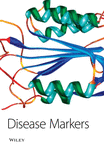PINCH Expression and Its Clinicopathological Significance in Gastric Adenocarcinoma
Abstract
Objective: Particularly interesting new cysteine-histidine rich protein (PINCH) is an important component of the local adhesion complexes and upregulated in several types of malignancies, and involved in the incidence and development of tumours. PINCH expression is also independently correlated with poorer survival in patients with colorectal cancer. However, there is no study of PINCH in gastric cancer, therefore, the aim of this project was to investigate PINCH expression and its clinicopathological significance in gastric adenocarcinoma.
Patients and methods: PINCH expression was immunohistochemically examined in normal gastric mucous (n = 30) and gastric adenocarcinoma (n = 73), from gastric cancer patients.
Results: PINCH expression in the associated-stroma of gastric cancers was heterogeneous, and its positive rate (75%) was higher than that of normal gastric mucosa (43%, X2 = 9.711, p = 0.002). The stronger staining was observed at the invasive edge of tumour when compared to the inner area of tumour. The rate of positive PINCH (88%) in the cases with lymph node metastasis was higher than that (52%) in the cases without metastasis (X2 = 11.151, p = 0.001). PINCH expression was not correlated with patients’ gender, age, tumour size, differentiation and invasion depth (p > 0.05).
Comclusion: PINCH protein might play an important role in the tumourigenesis and metastasis of gastric adenocarcinoma.




